Score:
76%
The batteries in Nokia's smartphone range continue to improve incrementally. First we have existing battery designs like the BL-5K getting 'upgraded' by another 100mAh, then we have the BV-4D on the Nokia 808 PureView, which proudly proclaims itself as providing '3.8V' rather than the familiar '3.7V'. All of which means that there's more power available per milliAmp hour. However, tracking how much battery power is left in your phone has never been more vague. The new version of PhoNetInfo can help slightly. But only slightly. And it may even add to the confusion!
Version Reviewed: 3.8.0
Buy Link | Download / Information Link
'Guesstimating' how much charge is left in a phone battery is a tricky business. The OS can log the load on the processor and hardware, the hardware can monitor the voltage the battery's currently providing, but neither method is anywhere near accurate.
The first is obviously something of a guess, while the latter is hampered by the very flat discharge curve of Li-Ion batteries, whereby the voltage stays more or less the same (a very shallow slope) for most of the discharge cycle (around the nominal voltage, whether 3.7 or 3.8V), with the extra complication that the voltage varies according to load and indeed the discharge curve itself gets modified once you start drawing significant current. And then consider that everything above varies dramatically according to ambient temperature - what a mess!
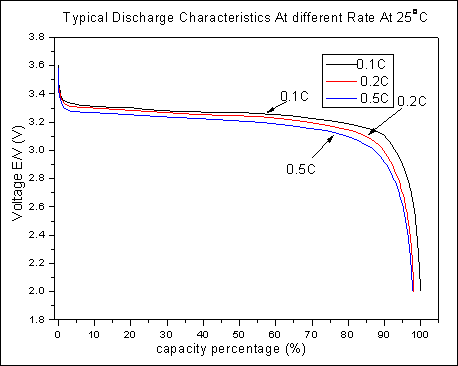
Chart from http://www.efirstpower.com/li.html
It's for this reason that you never get to see a reading of battery voltage in any of the traditional Symbian battery monitor utilities. Instead, the OS takes the physical and historical information available and makes (what is no more than) an educated guess, to estimate 'battery charge level' as a percentage of 'full'. Having tested several such utilities on the Nokia 808, with the nominally higher steady state battery voltage, I'm convinced that none work reliably.
The fault is Symbian's though, in that the 'level' reported is itself wrong, with algorithms probably rooted in the days of S60. So we have the situation where I can charge my Nokia 808 fully and then use it for an hour non-stop - and the 'battery charge level' is still reported to utilities as '100%', which is clearly wrong.
What I was looking out for, somewhat geekily, was a utility which reported the exact voltage currently available at the 808's battery terminals. Happily, PhoNetInfo 3.8.0, just released, provides just that, as shown below.
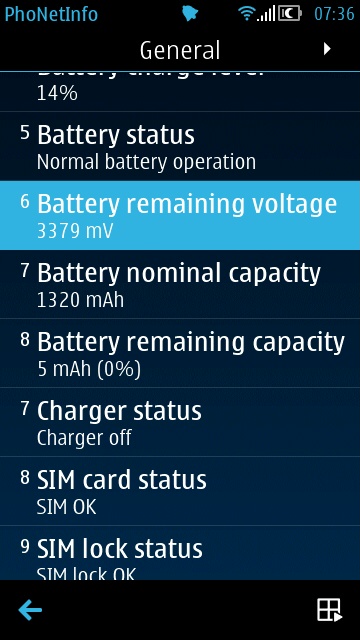
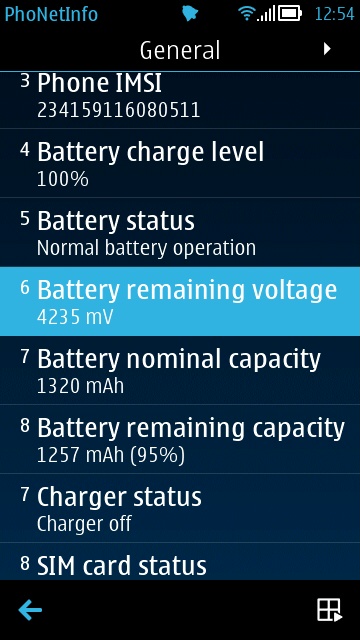
The 808 shown in almost-dead and fully-charged states
In fact, there are three figures, taken directly from a battery API:
- Battery remaining voltage. This seems accurate and matches technical documents on other Li-Ion battery technology. Just after charging, voltage is just above 4V, it then settles down to a guaranteed 3.8V or so (in the 808's case) for most of its usable charge, and then diminishes fast for the last 10% or so of usable charge.
- Battery nominal capacity. This is an odd figure - the BV-4D is rated at 1320mAh, but the battery itself is reporting less. It's possible my cell is slightly sub-par or the API could just be confused and not liking the new battery technology. I installed PhoNetInfo on my E7 with 1200mAh built-in cell and got a reading of "1279mAh", so something's clearly a bit screwy here.
- Battery remaining capacity. This is perhaps the most useful figure in the whole of the utility. This is the battery's control circuitry reporting the estimated amount of usable charge left. Yes, it's an estimate (as opposed to the 'exact' voltage reading above), but in my tests it proved pretty accurate.
Note too, that it's a percentage of 'nominal' capacity and that it doesn't start from 100%, since every battery is degraded from factory-fresh-state by simply being used. When fully charged, my 808 showed '95%', showing that the battery's capacity has (probably) degraded by 5% in a month of use, which sounds about right.
As I use my phone, the 'remaining capacity' starts going down immediately, showing that it's more accurate and relevant that the 'charge level' figure calculated by the OS.
In short, the stats above are a heck of a lot more use than the single figure given by the OS to most battery utilities, and make PhoNetInfo worth its purchase price for this function alone.
There's lots more that PhoNetInfo can report on though:
- firmware version
- IMSI
- IMEI
- SIM card status
- WLAN IP
- MAC address
- MTU and speed
- Bluetooth MAC and device class
- network mode, name, signal strength, (cell) ID and country code
- CPU speed, type and architecture
- RAM and ROM
- running tasks
... and much more, all laid out in a slightly quirky tabbed dialog format.
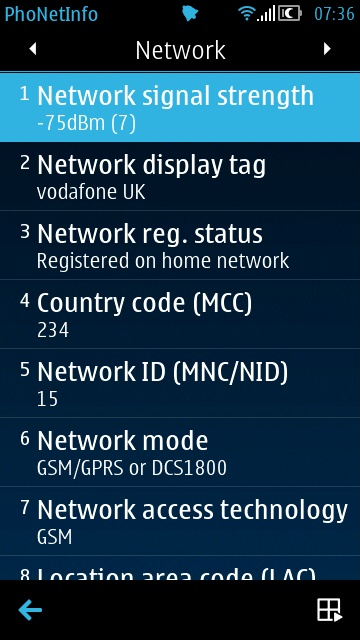
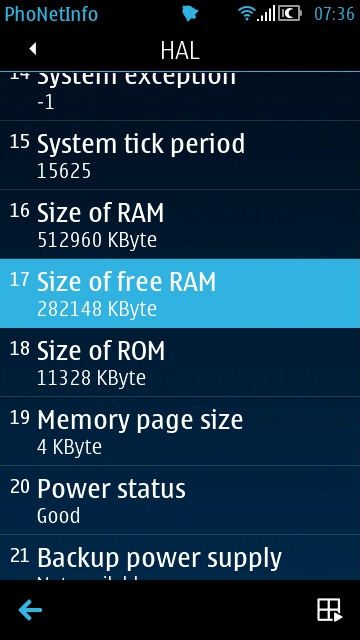
Everything shown on the screen can be copied to the Symbian clipboard or even dumped, page by page, into a text file of your choice. Perfect for diagnosing an issue. Or... just..... reviewing PhoNetInfo for All About Symbian...!
The information presented by PhoNetInfo is wonderfully geeky in a totally over-the-top fashion. If all of this sounds like you, or if you would just a better handle on exactly what the battery in your smartphone is up to, then this is a definite recommended £1 purchase in the Nokia Store.
PS. If anyone figures out the mysteries of the 'nominal capacity' figures shown, do please comment or email me!
Reviewed by Steve Litchfield at
No hay comentarios:
Publicar un comentario